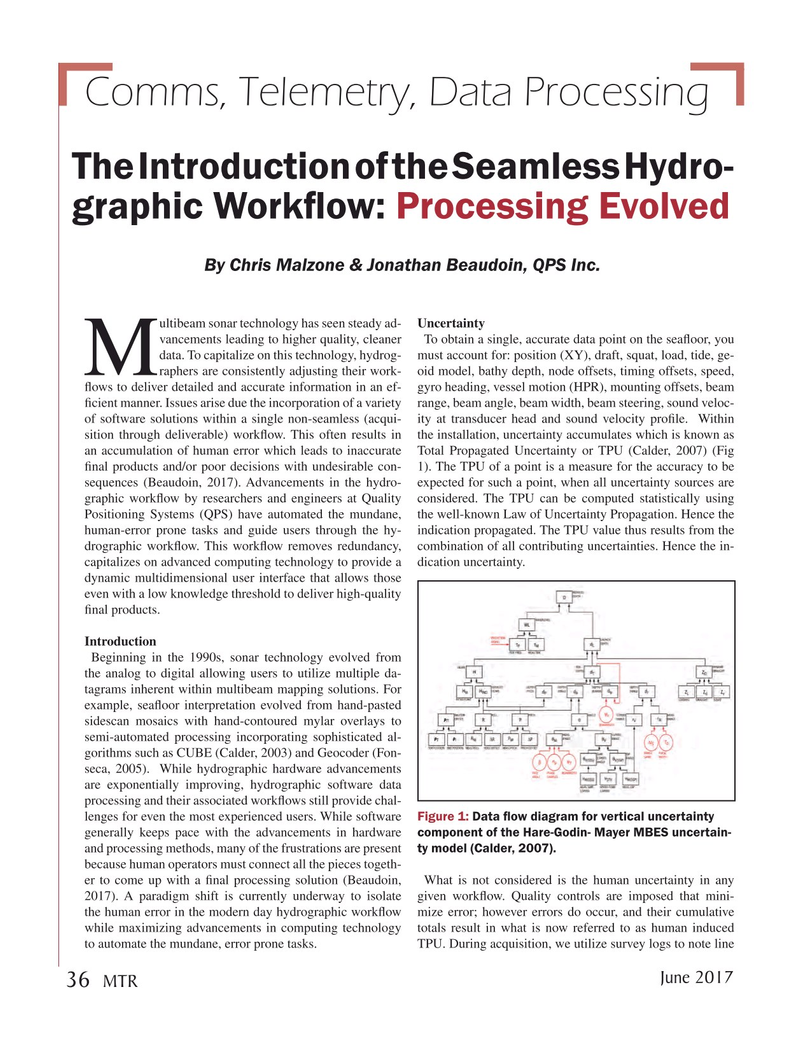
Page 36: of Marine Technology Magazine (June 2017)
Hydrographic Survey
Read this page in Pdf, Flash or Html5 edition of June 2017 Marine Technology Magazine
Comms, Telemetry, Data Processing
The Introduction of the Seamless Hydro- graphic Work? ow: Processing Evolved
By Chris Malzone & Jonathan Beaudoin, QPS Inc.
ultibeam sonar technology has seen steady ad- Uncertainty vancements leading to higher quality, cleaner To obtain a single, accurate data point on the sea? oor, you data. To capitalize on this technology, hydrog- must account for: position (XY), draft, squat, load, tide, ge-
Mraphers are consistently adjusting their work- oid model, bathy depth, node offsets, timing offsets, speed, ? ows to deliver detailed and accurate information in an ef- gyro heading, vessel motion (HPR), mounting offsets, beam ? cient manner. Issues arise due the incorporation of a variety range, beam angle, beam width, beam steering, sound veloc- of software solutions within a single non-seamless (acqui- ity at transducer head and sound velocity pro? le. Within sition through deliverable) work? ow. This often results in the installation, uncertainty accumulates which is known as an accumulation of human error which leads to inaccurate Total Propagated Uncertainty or TPU (Calder, 2007) (Fig ? nal products and/or poor decisions with undesirable con- 1). The TPU of a point is a measure for the accuracy to be sequences (Beaudoin, 2017). Advancements in the hydro- expected for such a point, when all uncertainty sources are graphic work? ow by researchers and engineers at Quality considered. The TPU can be computed statistically using
Positioning Systems (QPS) have automated the mundane, the well-known Law of Uncertainty Propagation. Hence the human-error prone tasks and guide users through the hy- indication propagated. The TPU value thus results from the drographic work? ow. This work? ow removes redundancy, combination of all contributing uncertainties. Hence the in- capitalizes on advanced computing technology to provide a dication uncertainty.
dynamic multidimensional user interface that allows those even with a low knowledge threshold to deliver high-quality ? nal products.
Introduction
Beginning in the 1990s, sonar technology evolved from the analog to digital allowing users to utilize multiple da- tagrams inherent within multibeam mapping solutions. For example, sea? oor interpretation evolved from hand-pasted sidescan mosaics with hand-contoured mylar overlays to semi-automated processing incorporating sophisticated al- gorithms such as CUBE (Calder, 2003) and Geocoder (Fon- seca, 2005). While hydrographic hardware advancements are exponentially improving, hydrographic software data processing and their associated work? ows still provide chal- lenges for even the most experienced users. While software Figure 1: Data ? ow diagram for vertical uncertainty generally keeps pace with the advancements in hardware component of the Hare-Godin- Mayer MBES uncertain- and processing methods, many of the frustrations are present ty model (Calder, 2007). because human operators must connect all the pieces togeth- er to come up with a ? nal processing solution (Beaudoin, What is not considered is the human uncertainty in any 2017). A paradigm shift is currently underway to isolate given work? ow. Quality controls are imposed that mini- the human error in the modern day hydrographic work? ow mize error; however errors do occur, and their cumulative while maximizing advancements in computing technology totals result in what is now referred to as human induced to automate the mundane, error prone tasks. TPU. During acquisition, we utilize survey logs to note line
June 2017
MTR 36
MTR #5 (34-47).indd 36 MTR #5 (34-47).indd 36 5/25/2017 2:37:01 PM5/25/2017 2:37:01 PM

 35
35

 37
37
